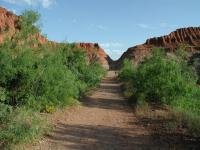
The trail near the trailhead pushes through a gap in the ridge ahead.
Getting there: From the park entrance drive north on the park's main road. Turn right at the fork in the road after Lake Theo. Continue driving past the Little Red Tent Camping Area and then look for trailhead parking on the right.
The Hike: Our hike begins at the waypoint "Trailhead" at a parking area with ample space, since we're the only ones here. The trail heads north from the trailhead with the John Haynes Ridge on the left.
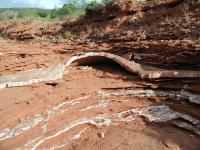
Caprock Canyons is loaded with Gypsum layers and they sometimes form domes or bubbles like this one.
Before starting the hike we noticed that the official park map warns that the Upper Canyon Trail was "extremely steep & rugged". Thinking that such a warning was geared towards the more casual visitor, we took the warning with a grain of salt. It turns out that the warning was well warranted.
For now, the trail is anything but steep and rugged. As it skirts the perimeter of the ridge the going is easy on the trail over the packed dirt and rock. Periodic creek bed crossing also mix in some sand for good measure. There's little to no shade at the start of the hike.
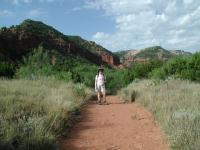
Coppertone on the trail. Eventually we'll end up in the canyon seen in the distance.
We had not traveled much more than a mile into the hike when we were surprised by a visitor on the trail. A young Coyote emerged from the brush and quickly high-tailed it down the trail away from us. It was the first time my wife and I had ever seen a Coyote on a hike.
By far, the most common animal that we saw on the trail was Quail. We unintentionally stirred up several coveys along the trail. Their sudden, unexpected bursts of mass flight from the brush as we passed by was startling at first. After about four incidents of this we got a little more used to it.
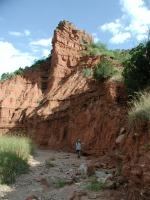
The trail at the lower elevations make frequent creek crossings. Here Austin Explorer poses near a cliff overlooking the creek.
When the trail heads west it will eventually start to gain in altitude following a stream bank. With the ascent the surrounding vegetation became thicker and tree cover began to provide some relief from the heat of the Sun we experienced up to this point. We saw numerous Oaks on the way up, something we don't recall seeing on our Canyon Rim hike nor at any point in Palo Duro Canyon.
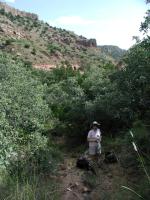
Coppertone pauses for a water break after the trail turned steep on its way up the canyon.
The hike up the valley toward Fern Cave is very steep in places. But some added elements make the trek even more challenging. First, many of the trails in Caprock Canyon were overgrown on our visit, so the trail was not always perfectly clear and pushing through grasses was often required. At one point on the ascent the trail signs point to using the dry, boulder-strewn stream bed. The problem was, we failed to notice any sign indicating when to leave the stream bed. Eventually we followed a secondary stream bed that forked in the direction of the trail according to the park maps and we soon rejoined the official route.
Fern Cave at the waypoint of the same name is a rock overhang covered in ferns that grow at the source of an Ogallala Aquifer spring. The constant stream of water here provides the required habitat for plants that could not possibly otherwise grow in this area. On the cliff overlooking Fern Cave is a small opening that might very well be a real cave in and of itself, though it is not accessible from the trail.
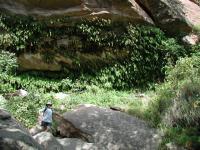
Austin Explorer stands on some boulders under the grotto near Fern Cave.
Even with all of the climbing that we've done, there is still some more to do before we get to the top of the ridge. So Fern Cave is a good spot to stop for a bit of a break. The final steps up to the top are steep and rocky and once you top out on the ridge you won't find as much shade as can be found here.
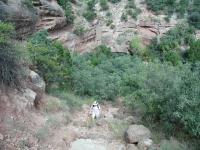
Fern Cave may be near the top of the bluff, but there's more altitude to be gained.
From the top of the ridge you can see Texas 256, the road just to the north of the park. The sound from the road is not too noticeable and most vehicles are largely hidden by the terrain. Thankfully this intrusion does not make its presence felt for very long on this hike.
The descent down from the ridge in some ways is harder that the ascent. A few spots are steep enough and covered in a suitable amount of scree that sliding a small section on one's butt seemed to be the safest choice. Boulder fields on the way down also obscure the route of the trail. Keep a close eye on the brown trail markers to lead the way.
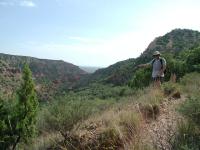
Austin Explorer points to the bottom of the valley from which we came.
Also don't forget to pause every now and then and take a look around. The trail descends into South Prong Canyon. Once below the ridge line any sound from the distant road is long gone. What replaces that is the sound of hawks and numerous other birds throughout the canyon.

Coppertone slowly works her way down the steep trail.
The trail turns to the east after it hits the canyon floor. It follows a creek generally southeast and makes numerous creek bed crossings. None of the crossings presented any problems as we encountered no water. However the sand patches get quite large and thick in this area and one might picture a beach stroll instead of a Panhandle hike.
The trail proper ends at the waypoint "Alt-TH". A small, separate spur also leads to the parking lot near the end of the trail. There are two ways to get to the starting trailhead, turn around and double back up and around the ridge, or walk along the park road towards the northeast. The later option is the one we took considering that we'd already gotten a good workout for the day.
In the end we hiked almost 6.5 miles, not counting the trip back to the car. While we
did see some vehicles in the distance on Texas 256, we saw no one else for the five hours or so we were on the trail. This trail lived up to its billing as steep and rugged, but the views from the top of the ridge made the effort worth it.